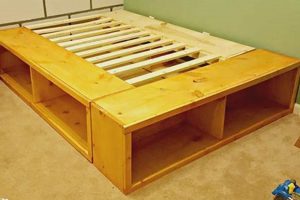A self-constructed container, tailored to fit within the main triangle of a bicycle’s frame, provides storage space for essential items. The construction involves measuring the frame dimensions, selecting durable materials, sewing fabric panels, and attaching securing straps. An example would be a cyclist creating a bag to hold tools, a water reservoir, or spare clothing during a long-distance ride.
Such a creation offers several advantages. It allows for customized sizing and features, optimizing space utilization within the bicycle’s frame. Economically, it presents a cost-effective alternative to commercially available options. Historically, cyclists have adapted and modified equipment to suit individual needs and improve performance, with this type of construction being a continuation of that spirit of resourcefulness and self-reliance.
The subsequent sections will explore various aspects of the construction process, including material selection, design considerations, and different attachment methods. It will also cover common challenges encountered during fabrication and provide solutions for achieving a durable and functional result.
Construction Tips for Frame-Integrated Bicycle Storage
This section presents practical recommendations to optimize the creation of bicycle frame storage solutions. Adhering to these suggestions can enhance the durability, functionality, and overall aesthetic of the finished product.
Tip 1: Material Selection is Critical: Opt for durable, water-resistant fabrics such as ripstop nylon or Cordura. These materials withstand abrasion and protect contents from the elements. For example, using a heavier-weight Cordura for the bottom panel increases resistance to wear from road debris.
Tip 2: Accurate Measurement is Paramount: Precisely measure the interior dimensions of the bicycle frame. Templates created from cardboard or paper allow for iterative adjustments before cutting fabric. Discrepancies in measurement can lead to a poorly fitting bag and compromised functionality.
Tip 3: Reinforce Stress Points: Areas where straps attach to the bag and corners that experience high stress should be reinforced. Use multiple layers of fabric or webbing to prevent tearing. An example would be reinforcing the zipper ends to avoid zipper failure.
Tip 4: Utilize Appropriate Sewing Techniques: Employ techniques like French seams or flat-felled seams to enhance the strength and water resistance of the construction. These seams encapsulate raw edges, preventing fraying and improving the overall durability of the bag.
Tip 5: Implement Secure Attachment Methods: Use robust Velcro straps, cam buckles, or bolt-on systems to securely attach the storage solution to the bicycle frame. Ensure straps are properly positioned to avoid interference with cables or the rider’s legs. An example is using non-slip material on the inside of the straps.
Tip 6: Consider Zipper Selection: Invest in high-quality zippers, preferably with weather-resistant features. A zipper failure can render the bag unusable. An example of a good choice is a YKK waterproof zipper.
Tip 7: Prototype Before Final Construction: Create a prototype from inexpensive materials like muslin before cutting the final fabric. This allows for testing the design and making adjustments without wasting valuable resources.
Adherence to these guidelines fosters a robust and practical frame-integrated bicycle storage solution, enhancing cycling experiences through improved cargo management and equipment accessibility.
The following section will address common modifications and customization techniques for adapting standard designs to unique frame geometries and storage requirements.
1. Dimensions
The dimensional aspects are paramount when creating a self-made bicycle frame container. Accurate sizing dictates fit, affects load distribution, and ultimately determines the bag’s utility. Ignoring dimensional precision compromises the project from inception.
- Interior Triangle Measurement
This involves measuring the inner area of the bicycle frame’s main triangle. The top tube length, seat tube length (or usable portion thereof), and down tube length, along with the angles between these tubes, all contribute. Accurate measurements dictate the maximum size of the container. Inaccurate data can result in a bag that is too large to fit, or too small to be useful.
- Tube Diameter Considerations
The diameter of the frame tubes influences the contours of the bag. A container designed for a frame with round tubes will not fit correctly on a frame with aero-shaped tubes. Allowance must be made for the tube diameter when creating the pattern to ensure a snug, but not overly tight, fit. This detail ensures that straps can properly secure the bag, preventing movement and chafing during use.
- Clearance for Components
Frame bags cannot impede the function of other components. Clearance for water bottle cages, front derailleurs, rear shocks (on full-suspension bikes), and the rider’s legs must be factored into the design. Failure to account for these elements leads to interference and reduces the bag’s practicality. For example, a bag that rubs against the rider’s knees is both uncomfortable and unsafe.
- Seam Allowance and Fabric Thickness
Pattern dimensions must account for seam allowances needed for construction, as well as the thickness of the fabric being used. Adding the seam allowance to the outside dimensions will result in an undersized bag. Failing to account for fabric thickness, particularly with thicker materials like waxed canvas or multiple layers, can also create a bag that is too small.
The correlation between meticulously assessed dimensions and the ultimate success of a frame-integrated bicycle storage solution cannot be overstated. Precise attention to these dimensional factors optimizes functionality, fit, and overall utility, contributing directly to an enhanced cycling experience. Conversely, neglecting them results in a bag of compromised value.
2. Materials
Material selection profoundly influences the functionality, durability, and aesthetic appeal of a self-constructed bicycle frame container. The choice of fabric, thread, and other components dictates the bag’s ability to withstand environmental factors, resist wear and tear, and securely carry its contents. Strategic material selection is thus an integral aspect of the creation process.
- Fabric Selection and its Implications
The fabric forms the primary barrier against the elements and abrasion. Materials such as Cordura, X-Pac, and ripstop nylon offer varying degrees of water resistance, tear strength, and weight. For instance, Cordura 1000D provides exceptional durability for high-wear areas, while a lighter ripstop nylon is suitable for internal pockets. The selection depends on the intended use, balancing durability with weight considerations. The wrong fabric can lead to premature failure and compromised cargo protection.
- Thread Type and Seam Integrity
The thread used to stitch the bag together must withstand repeated stress and environmental exposure. Heavy-duty nylon or polyester threads are preferred for their strength and resistance to UV degradation. The thread gauge should be appropriate for the fabric; using too thin a thread on a heavy fabric can result in seam failure. Conversely, using too thick a thread on lightweight fabric can damage the material. Proper thread selection is thus crucial for maintaining the bag’s structural integrity.
- Fasteners and Closure Systems
Zippers, buckles, and hook-and-loop fasteners are integral to accessing and securing the contents. High-quality zippers, such as those from YKK, offer reliable performance and resistance to water ingress. Buckles should be chosen based on their strength and ease of use, while hook-and-loop closures must provide a secure grip and maintain their effectiveness over time. Compromised fasteners lead to insecure storage and potential loss of contents.
- Reinforcement Materials and Structure
Webbing, binding tape, and closed-cell foam contribute to the bag’s structure and durability. Webbing reinforces attachment points and provides abrasion resistance. Binding tape finishes raw edges, preventing fraying and adding to the bag’s visual appeal. Closed-cell foam can be used to add padding and protect delicate contents. These materials enhance the bag’s lifespan and functionality.
Ultimately, the combined selection of these materials directly dictates the performance and longevity. A cohesive material strategy, prioritizing durability, water resistance, and appropriate weight, maximizes the value and utility. Conversely, skimping on quality undermines the entire endeavor, resulting in a bag that is aesthetically pleasing but functionally deficient.
3. Attachment
Secure and reliable attachment constitutes a pivotal consideration in the design and fabrication of a self-made bicycle frame container. The chosen attachment method directly influences the bag’s stability, accessibility, and overall functionality. Inadequate attachment systems compromise the container’s purpose, potentially leading to instability, damage, or loss of contents.
- Strap Systems and Their Variations
Strap systems represent a prevalent attachment method, utilizing hook-and-loop fasteners, cam buckles, or a combination thereof. Hook-and-loop straps offer adjustability and ease of use, while cam buckle straps provide a more secure and load-bearing attachment. The configuration and placement of straps dictate the distribution of load across the frame tubes. An example includes using wide, non-slip straps to prevent shifting during off-road riding. Inadequate strap placement or insufficient strap strength results in movement and potential abrasion of the frame.
- Bolt-On Attachment and Frame Compatibility
Bolt-on attachment involves securing the container directly to existing frame mounts, such as water bottle cage bosses. This method offers a secure and streamlined attachment, minimizing movement and improving aesthetics. However, compatibility is contingent upon the presence and spacing of frame mounts. Modifications to the frame may be required to implement this attachment method. Frame damage can occur if bolt-on systems are improperly installed or overtightened.
- Attachment Point Reinforcement and Durability
Areas where straps or bolts attach to the container experience significant stress. Reinforcement of these attachment points is critical for preventing tearing and ensuring long-term durability. This can be achieved through multiple layers of fabric, webbing, or the addition of metal grommets. The absence of reinforcement results in premature failure of the attachment system, rendering the bag unusable.
- Cable Routing and Interference Mitigation
Attachment methods must consider the routing of brake and gear cables. Straps should be positioned to avoid impeding cable movement or creating unnecessary friction. Bolt-on systems must be designed to avoid pinching or damaging cables. Failure to address cable routing issues leads to impaired shifting and braking performance.
The selection and implementation of an appropriate attachment strategy are crucial for a functional frame-integrated bicycle storage container. Careful consideration of strap placement, bolt-on compatibility, reinforcement needs, and cable routing minimizes the risk of instability, damage, and performance degradation, thereby maximizing the utility of the storage solution.
4. Construction
The construction phase represents the practical realization of a self-made bicycle frame container. This stage transforms initial design concepts and material selections into a tangible and functional storage solution. The quality of execution during construction dictates the bag’s overall durability, performance, and aesthetic appeal. Diligence and precision are paramount throughout this process.
- Pattern Creation and Fabric Cutting
Accurate pattern creation forms the foundation of the construction process. Templates, often derived from precise frame measurements, guide the cutting of fabric panels. Errors during pattern creation or cutting propagate throughout the construction, leading to a poorly fitting and non-functional bag. For example, a pattern that neglects seam allowances will result in a container that is too small. Precision in this initial step is essential for achieving a satisfactory final product.
- Seam Selection and Sewing Techniques
The choice of seam type and sewing technique significantly impacts the bag’s strength and water resistance. French seams and flat-felled seams encapsulate raw edges, preventing fraying and enhancing durability. Reinforced stitching at stress points, such as attachment points and zipper ends, provides added security. Improper seam selection or poor sewing technique compromises the bag’s structural integrity and lifespan. A common mistake is using a standard straight stitch on a high-stress seam, leading to premature failure.
- Zipper and Closure Installation
Proper installation of zippers and other closure systems is critical for accessibility and security. Zippers must be aligned correctly and sewn securely to prevent snagging or separation. Weather-resistant zippers offer added protection against the elements. Hook-and-loop closures must be properly positioned and stitched to provide a secure grip. A poorly installed zipper or closure renders the bag difficult to use and compromises its ability to protect its contents.
- Finishing and Edge Treatment
Finishing details, such as binding raw edges with tape or adding reinforcing webbing, enhance the bag’s durability and visual appeal. Binding tape prevents fraying and provides a clean, professional finish. Reinforcing webbing adds abrasion resistance to high-wear areas. Neglecting these finishing details detracts from the overall quality and shortens the bag’s lifespan.
In essence, the construction phase necessitates meticulous attention to detail, from pattern creation to final finishing. Each step builds upon the preceding one, and any compromise in quality at one stage jeopardizes the integrity of the entire project. A well-constructed frame-integrated bicycle storage container reflects a commitment to precision and craftsmanship, yielding a durable and functional addition to the cyclist’s equipment.
5. Durability
The longevity of a self-constructed bicycle frame container is inextricably linked to its construction materials and techniques. Environmental factors inherent in cycling, such as abrasion from road debris, exposure to moisture, and prolonged UV radiation, continuously challenge the integrity of the bag. The selection of robust, weather-resistant fabrics, such as Cordura or X-Pac, represents a proactive measure to mitigate these effects. Similarly, the utilization of heavy-duty thread and reinforced stitching at stress points, particularly around attachment hardware and zipper terminations, significantly enhances structural resilience. The failure to prioritize these elements during the creation phase results in a container susceptible to premature wear, compromised functionality, and an ultimately diminished lifespan. An example is a bag constructed from standard cotton canvas quickly deteriorating under prolonged exposure to rain and sunlight, contrasted with one utilizing coated nylon demonstrating years of reliable service.
The influence of operational conditions on the durability of these containers also necessitates consideration. Off-road cycling, with its increased exposure to mud, rocks, and vegetation, presents a more rigorous test of the bag’s construction than leisurely road riding. Consequently, a design intended for off-road use demands a higher degree of reinforcement and abrasion resistance. Specific strategies include employing multiple layers of fabric in high-wear areas, incorporating protective panels made of durable materials like ballistic nylon, and utilizing water-resistant zippers with storm flaps. A container designed for casual use that is subjected to frequent off-road excursions will likely exhibit accelerated wear and require more frequent repairs or replacement.
In conclusion, a correlation exists between the initial design choices and construction quality and the ultimate lifespan of a frame-integrated bicycle storage solution. While meticulous design and construction contribute significantly to mitigating common failures, external operational conditions also affect the bags integrity. Therefore, careful material and construction selection must accommodate the intended usage context to achieve the targeted durability. Neglecting this factor translates to diminished functional life and increased long-term cost, negating the economic benefits frequently associated with self-constructed equipment.
6. Customization
The inherent flexibility of self-fabrication allows for substantial adaptation to individual needs and bicycle geometries, making customization a defining characteristic of self-made bicycle frame containers.
- Frame Geometry Accommodation
Bicycle frames exhibit considerable variation in shape and size. Mass-produced bags may not perfectly fit all frames, leading to inefficient space utilization or interference with other components. Tailoring a bag to the specific dimensions of a bicycle frame maximizes storage capacity and ensures a streamlined profile. An example includes a bag designed to fit within the limited space of a small-sized frame or one configured around the unique tube angles of a recumbent bicycle. This individualized fit enhances stability and prevents abrasion.
- Storage Compartment Configuration
Cyclists have diverse storage requirements based on the type of riding and equipment carried. Customization enables the creation of specialized compartments for specific items, such as water reservoirs, tools, electronics, or food. Internal dividers, pockets, and straps can be strategically positioned to organize and secure these items. For instance, a long-distance cyclist may require a dedicated compartment for a hydration bladder and another for easily accessible snacks, while a commuter may prioritize a padded compartment for a laptop. Optimized storage reduces clutter and improves accessibility.
- Material Selection for Specific Conditions
Environmental factors significantly impact the performance of a bicycle frame container. Customization allows for the selection of materials best suited to specific riding conditions. For example, a cyclist frequently riding in wet conditions may opt for waterproof fabrics and zippers, while one primarily riding in dry climates may prioritize lightweight and breathable materials. Reinforcement materials can be strategically placed in high-wear areas to enhance durability. Adaptive material selection ensures optimal performance and longevity.
- Aesthetic Personalization
Beyond functional considerations, customization allows for personal expression through material choices and design elements. Color selection, fabric patterns, and the addition of custom logos or reflective accents enable cyclists to create a bag that reflects their individual style. While aesthetic considerations do not directly impact performance, they contribute to a sense of ownership and pride. Coordinating the bag’s appearance with the bicycle’s color scheme or adding a personalized patch demonstrates this aspect of custom creation.
These examples illustrate the versatility afforded by self-made bicycle frame containers. By adapting the design, materials, and features to specific needs and preferences, cyclists can create a storage solution that is both functional and personally meaningful. Commercial options rarely offer the same degree of nuanced tailoring.
Frequently Asked Questions
The subsequent questions and answers address common inquiries and misconceptions regarding the design, construction, and utilization of bicycle frame containers created through do-it-yourself methods.
Question 1: What level of sewing expertise is required to successfully construct a frame container?
A functional frame container necessitates at least intermediate sewing skills. Proficiency in operating a sewing machine, creating seams, and working with durable fabrics is essential. Familiarity with pattern making and basic geometry aids in achieving accurate dimensions.
Question 2: Are specialized tools necessary for fabricating a frame container?
While basic sewing tools, such as a sewing machine, scissors, and measuring tape, are fundamental, specialized tools enhance the process. A rotary cutter and cutting mat facilitate precise fabric cutting. A heavy-duty sewing machine capable of handling thick fabrics is recommended. Specialized needles for sewing through multiple fabric layers are also beneficial.
Question 3: What is the expected lifespan of a self-made frame container compared to a commercially produced one?
The lifespan of a self-made frame container varies significantly based on material selection, construction quality, and usage conditions. While professionally manufactured bags often undergo rigorous testing, a well-constructed self-made container using durable materials can achieve comparable longevity. However, inconsistent construction or the use of substandard materials can result in premature failure.
Question 4: How is water resistance achieved in a self-constructed frame container?
Water resistance is achieved through strategic material selection and construction techniques. Utilizing water-resistant fabrics, such as coated nylon or laminated materials, is paramount. Sealing seams with seam tape or employing waterproof zippers further enhances water resistance. A completely waterproof container may require specialized knowledge and equipment.
Question 5: Can a self-made frame container be as secure as a professionally designed one?
Security depends on the attachment method and construction quality. Secure attachment requires robust straps, buckles, or bolt-on systems properly anchored to the frame and the container. Reinforced stitching and durable attachment hardware are essential. A poorly designed or constructed attachment system compromises security and may lead to detachment during use.
Question 6: What are the potential risks associated with improperly installed frame containers?
Improperly installed frame containers present several risks. Interference with brake or gear cables can impair bicycle performance. Abrasion of the frame finish can occur due to inadequate padding or loose straps. Instability can compromise handling and safety. Overtightening bolts on bolt-on systems can damage the frame. Thoroughly assessing compatibility and following proper installation procedures minimizes these risks.
In summary, constructing a functional and durable frame container requires careful planning, proficient sewing skills, and strategic material selection. While challenges exist, the potential for customization and cost savings makes it an appealing project for resourceful cyclists.
The subsequent section explores advanced modifications and customization techniques for adapting standard designs to unique frame geometries and storage requirements.
Conclusion
This exploration of the diy bicycle frame bag has examined diverse aspects, ranging from dimensional considerations and material selection to construction techniques and customization options. Emphasis has been placed on the integration of design principles with practical execution, underscoring the critical role of precision and material quality in determining the utility and longevity of such a construct. Secure attachment methodologies and environmental resistance strategies were also highlighted as essential components of a functional design.
While self-fabrication presents an avenue for tailored storage solutions and potential cost savings, the undertaking demands a commitment to skill acquisition and meticulous execution. Potential fabricators should carefully assess their technical capabilities and resource availability before embarking on such projects. Continued innovation in materials and construction techniques promises future refinements in the practicality and durability of diy bicycle frame bag designs.







